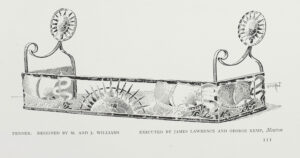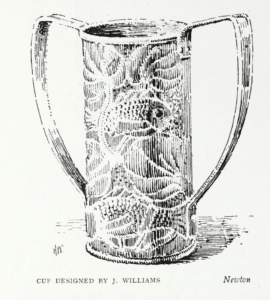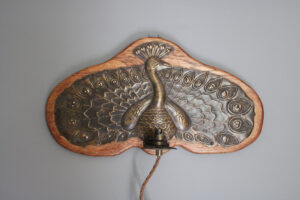-
Formation of the Home Arts and Industries Association
Formed by Eglantyne Louisa Jebb – sought to revive traditional rural crafts. Aligned to the thinking of John Ruskin and the Arts and Crafts Movement ethos. By 1889 there were over 450 classes, 1000 teachers and 5000 students.
-
Metalwork classes started in Newton
Metal Work classes started in Newton by Harold Hurrell and Miss Nash. Likely to have been winter evening classes.
-
Exhibit at the Industrial Loan and Exhibition in Royston
“Among articles not for competition, special mention should be made of the interesting collections of artistic handiwork sent in from the Newton Evening School under the direction of Mr. Hurrell and Miss Nash. From the Newton School 64 articles were exhibited. Principal exhibits were in Venetian ironwork, repousse work in brass and copper many of the articles being pretty in design and of reasonable price.”
-
Metalwork exhibited in Cambridge
“The lads are provided with tools and materials, and after their work is done, the articles are sold, and all profit, after paying for materials, is divided amongst them. The articles were in many cases remarkably handsome, and the prices were unusually low. Stalls were presided over by Miss Nash and Mr Harold. W. Hurrell. The movement is one that could well be copied in other villages, but a different kind of work should be taught or the market will be overcrowded.”
-
Featured in The Studio Yearbook of Decorative Arts
The article covered the Home Arts and Industries Exhibition held at the Royal Albert Hall in London. The article states that some repousse work, in which the admirable influence of Essex House was apparent, came from Newton, near Cambridge. The reference to Essex House is a strong link with the Guild of Handicraft School which, by 1894, was based in Essex House in London.
-
Commissioned to make panels for the Prince of Wales
At the Cambridge Exhibition of Work by Technical Education Students, the Newton class topped the awards table with 13 certificates and 8 prizes in Iron work and repousse metalwork. Two panels were commissioned by the future Edward VII.
-
Exhibited at Cambridge Exhibition of Technical Work
“A magnificent lot of metalwork, Venetian bent ironwork, repousse work etc in various artistic designs”. First mention of Albert Prime who wins the First Prize in the Ironwork section.
-

Featured in The Studio Yearbook of Decorative Arts
170 pieces of metalwork exhibited in Cambridge.Forge work is now being done at the School.Newton mentioned in Studio write up of annual Home Arts and Industries Exhibition in London. “Mr J. Williams, from whom (especially in the Newton and Cambridge groups) came much of the best schemes in wrought metal throughout the gallery.” -

The Studio, Vol. 8 (1896); p.96.
Featured in The Studio Yearbook of Decorative Arts
A cup designed by John Williams and made by the Newton School was shown at the Home Arts and Industries Association exhibition in 1898 and illustrated by The Studio.
The excellence of the School’s work in Copper, brass and forged iron is praised at the Cambridge Exhibition. Ecclesiastical metalwork is also being made.
Students are also being taught drawing and clay modelling.
-
Metalwork exhibited at Guildhall in Cambridge
“The repousse metalwork was as usual a great feature. Newton occupies a prominent place. The workers there continue to send many of their articles all of which bear the mark of skilled workmanship, to outside markets, no less than £80 worth has been sold this season. A striking feature were some ornamental clock faces in copper and brass and a handsome font ewer having been brought from Waterbeach church as a specimen of Newton artistic handicraft.”
-
 Featured in The Artist
Featured in The ArtistThe school was also mentioned in the important periodical, The Artist. They stated that the work by the school was of a distinctly important character. A lantern, milk jug and string box were described as original shapes, showing a commendable striving after good form.
-
 Exhibition of Technical Instruction at Cambridge
Exhibition of Technical Instruction at Cambridge“Noone could fail to admire the splendid display of repousse metal objects, in which Newton, as usual were well to the fore. Some new work was shown this year by the students in the form of specimens of enamel work and log boxes. The former comprised various articles such as cigarette boxes and hair pin trays made of beaten metal riveted with hinged lids and various colours of stone worked in by way decoration. The other goods were quaintly made boxes for wooden logs to stand beside the fireplace. Both were extremely pretty and effective”.
-
Exhibited at Cambridge Exhibition of Technical Work
-
Article in the Cambridge Independent Press
“Public attention has been drawn to the very commendable local industry that is carried on at the little village of Newton in Cambridgeshire, through the exhibition now being held at South Kensington by the Home Arts and Industries Association. Our industrious friends at Newton take a foremost place in the local industries of East Anglia. Their speciality is metalwork, and visitors to the exhibition express astonishment that horsemen and ploughmen, as actually is the case here, could have found the patience to execute work with such care and skill. Under the guidance of Mr. H. Hurrell, who resides at Newton, practically all the agricultural labourers in the village have spent four evenings a week learning metalwork, with pleasing financial results to them – so the report say – and with credit to their instructor. One of the pupils, a ploughman, has made an altar cross, the ornamentation of which is so perfectly worked that the villages have subscribed the purchase price, £8, in order to place it in the church in memory of a lady benefactor. A coach house belonging to Mr Hurrell has been converted into a workshop, and here everything is done, no man getting less than 3s. for his week of four evenings. So far, it is stated, substantial sums have been earned in the aggregate, and in the last few years the articles made, which include hammered pewter, have brought in £300. This is the sort of self help which deserves encouragement and support”
-
Exhibited at Arts and Crafts Exhibition in Ipswich
“The Newton School of Metal Work held in the village of Newton, near Cambridge, which has a population of about 156 inhabitants, sent a large variety of examples of metalwork done by the students, who are mostly youths and men that work on the land. The stall is also in the main hall. The display was arranged by Mr. H. W. Hurrell , who manages the class and who states that the work which has been fostered by the County Council and is in connection with South Kensington began in 1890. The class consists of about twenty persons and, at the exhibition of the Home Arts and Industries in London, the Queen and other members of the Royal Family made purchases from their stall. One of the best pieces of work shown at the Ipswich exhibition is a copper bowl with a brass rim riveted on, which has been hammered out from the flat. There is also a muffin dish of copper, which is very creditable, the lid fitting most perfectly. There is a copper hand lantern made to an original design by a Ploughman and several artistic toasting forks made with steel wire by an engine driver. A youth of sixteen is responsible for a neat little sweet dish in pewter.”
-
Exhibited at the Arts and Crafts Exhibition in Cambridge